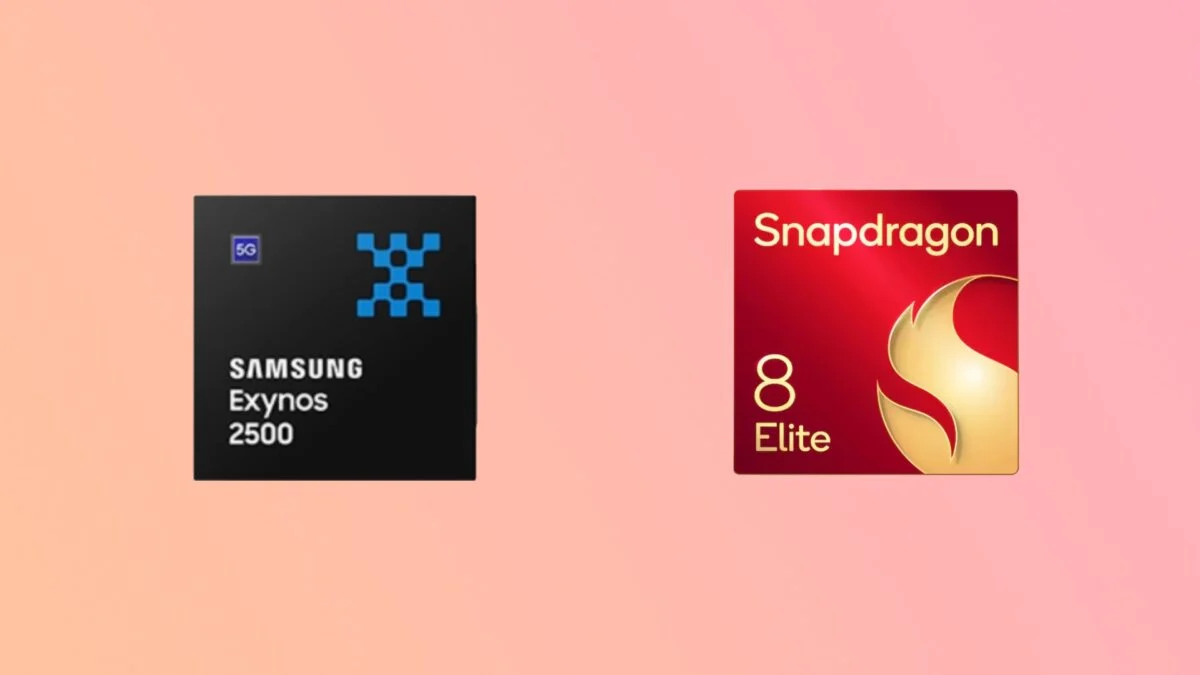Exynos 2500 vs. Snapdragon 8 Elite: A Deep Dive into the 3nm Chipset Battle

With the recent announcement of its first 3nm smartphone chip, the Exynos 2500, Samsung has set the stage for a fierce technological Exynos 2500 vs Snapdragon 8 Elite battle. This new silicon, slated to debut globally in the Galaxy Z Flip 7, goes head-to-head with Qualcomm‘s flagship Snapdragon 8 Elite. While real-world performance awaits testing, a detailed comparison of their on-paper specifications reveals a fascinating strategic divergence, particularly in CPU architecture and on-device Samsung AI capabilities.
Here’s a deep dive into how these two titans of mobile processing stack up.
Exynos 2500 vs Snapdragon 8 Elite: Manufacturing Process and CPU Architecture
Both chipsets are built on cutting-edge 3nm process technology, but their foundry origins differ. The Exynos 2500 is fabricated on Samsung Foundry’s 3nm Gate-All-Around (GAA) process, while the Snapdragon 8 Elite utilizes TSMC’s first-generation 3nm node. While TSMC’s process is often considered to have an edge, the true efficiency will only be proven in final retail devices.
The CPU configurations showcase distinct philosophies. Samsung opts for a 10-core setup in the Exynos 2500, focused on a mix of high-performance and efficiency cores. Qualcomm, meanwhile, employs a powerful 8-core custom Oryon CPU in the Snapdragon 8 Elite.
| Feature | Exynos 2500 | Snapdragon 8 Elite |
|---|---|---|
| Fabrication | 3nm GAA (Samsung Foundry) | 3nm (TSMC) |
| CPU | 10-Core (1x Cortex-X925 @ 3.3GHz + 7x A725 + 2x A520) | 8-Core (2x Oryon L @ 4.32GHz + 5x Oryon M @ 3.53GHz) |
| GPU | Xclipse 950 (AMD RDNA 3) | Adreno 830 |
| RAM | LPDDR5X | LPDDR5X |
| Storage | UFS 4.0 | UFS 4.0 |
| Modem Speed | 12.1Gbps (Peak Download) | 10Gbps (Peak Download) |
Leaked Geekbench benchmarks suggest the Exynos 2500‘s CPU performance is competitive, reportedly outperforming the Snapdragon 8 Elite variant found in some foldable competitors, though it may trail the version used in traditional “slab” flagships.
Graphics and On-Device AI: Where Samsung Shines
Samsung‘s collaboration with AMD continues with the new Xclipse 950 GPU, based on the RDNA 3 architecture. It’s said to be 50% more powerful than its predecessor, positioning it to be highly competitive with the Snapdragon 8 Elite‘s formidable Adreno 830 GPU.
However, the most significant on-paper advantage for Samsung lies in AI processing. The NPU inside the Exynos 2500 boasts an impressive 59 Trillion Operations Per Second (TOPS) of inferencing performance. While Qualcomm hasn’t specified the exact figure for the Snapdragon 8 Elite, it is expected to be lower than the 45 TOPS of its laptop-class Snapdragon X Elite chip. This gives the Exynos 2500 a clear lead in handling the demanding on-device Samsung AI features.
Exynos 2500 vs Snapdragon 8 Elite: Connectivity and Camera Capabilities
Both chipsets are packed with the latest connectivity standards, including Wi-Fi 7 and multi-frequency GNSS. However, the Exynos 2500‘s integrated 5G modem has a higher theoretical peak download speed of 12.1Gbps compared to the Snapdragon’s 10Gbps.
In terms of Exynos 2500 vs Snapdragon 8 Elite imaging, both SoCs are highly capable. They support camera sensors up to 320MP and 8K video recording at 30fps. Their Image Signal Processors (ISPs) offer slightly different multi-camera processing capabilities, but both can handle simultaneous image processing from high-resolution sensors with zero shutter lag.
In conclusion, the battle between the Exynos 2500 and the Snapdragon 8 Elite is shaping up to be a clash of strategies. The Exynos 2500 appears to hold an edge in AI processing and modem speed, central to the Samsung AI experience. The Snapdragon 8 Elite, in contrast, seems to prioritize raw CPU clock speed. With comparable GPU, memory, and storage support, the ultimate winner will be decided by real-world application performance and efficiency.




